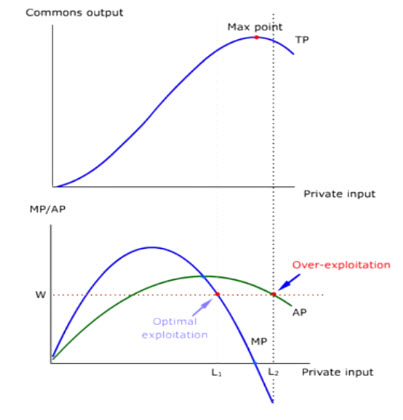Tragedy of the commons (transcript)
Narrated lecture on over-exploitation of commons resources due to unlimited entry.
Introduction
Resources owned in common are open to competitive capture. Unrestricted entry often leads to over-exploitation known as the tragedy of the commons.
Production function
Like other scarce resources, resources owned in common are subject to diminishing returns. Such characteristic is illustrated by a production function that enjoys increasing returns initially when additional private input is added. (animate) Namely, output increases at an increasing rate up to the inflection point. Then, total output suffers decreasing returns. (animate) Namely, output increases at a decreasing rate after the inflection point. Finally, output maxes out and starts to decline (animate).
MP and AP
The different phases of returns to additional private input can be illustrated more clearly by plotting the marginal product curve. The marginal product at a given level of input is measured by the slope of the tangent on the total product curve. Let us measure the slope at 4 different points on the TP curve and plot the values of the respective slopes onto the MP panel. (animate) MP goes up during the increasing-returns phase. (animate) MP reaches a maximum at the inflection point. (draw circle) MP goes down during the decreasing-returns phase. (animate) MP becomes zero at maximum TP. (draw circle) Then MP becomes negative as TP starts to decline. (animate)
Over-exploitation of commons resources would not happen if private input is applied with an eye to MP. But private input owners are more interested in the average product of the commons resources. Let us compare the AP with the MP at the same 4 points on the production function. (animate)
The important thing to notice is that AP is still positive when MP is zero or negative. (animate) In other words, AP is still positive when TP is falling.
Efficient exploitation
If a resource is privately owned, input will be applied to the resource only if the MP of the input is at least equal to its opportunity cost. Loss will be incurred if MP is less than the opportunity cost of the input. Specifically, if the opportunity cost of the input is W, (animate) only L1 will be applied. Notice that efficient exploitation of private property stops well short of maximum TP.
Free entry
But if the resource is owned in common, owners of private input will care only about whether on average the returns to their input is at least equal to its opportunity cost. In other words, they would compare W with AP. The fact that an additional input would reduce MP to below W is a negative externality that they need not be concerned with since the resource is owned in common.
When W is equated to AP, L2 input will be applied to the commons resource even though MP is negative. The degree of over-exploitation can be measured by the excess of L2 over L1.

Summary
The tragedy of the commons is an illustration of the simple truth that “everybody’s property is nobody’s property.”
Topics:
Keywords
average product, commons, externality, free entry, marginal product, property rights, total product
